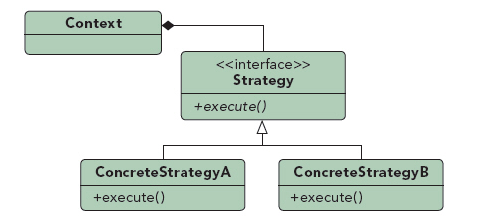源码地址:https://github.com/weilanhanf/PythonDesignPatterns
说明:
策略指的就是为了达到某一目的而采取的手段或者方法。为了实现软件设计咪表,对象可能会用到多种多样的算法。这些算法甚至会经常改变。如果将这些算法都硬编码到对象中,将会使得对象本身变得臃肿不堪,而且有时候支持不同的算法也是一个性能负担。策略模式很好的实现了在运行时根据需要透明的更改对象的算法和将算法与本身对象解耦,从而避免出现上述两个问题。
因此策略模式可以定义为: 定义一系列算法,将每一个算法封装起来,并让它们可以相互替换。策略模式让算法可以独立于使用它的客户变化。每一个封装算法的类称之为策略(Strategy)类,策略模式提供了一种可插入式(Pluggable)算法的实现方案

策略模式的结构
策略模式包含以下3个角色: Context(环境类) Strategy(抽象策略类) ConcreteStrategy(具体策略类)
实例:
假设某司维护着一些客户资料,需要在该司有新产品上市或者举行新活动时通知客户。现通知客户的方式有两种:短信通知、邮件通知。应如何设计该系统的客户通知部分?为解决该问题,我们先构造客户类,包括客户常用的联系方式和基本信息,同时也包括要发送的内容。
class customer: customer_name="" snd_way="" info="" phone="" email="" def setPhone(self,phone): self.phone=phone def setEmail(self,mail): self.email=mail def getPhone(self): return self.phone def getEmail(self): return self.email def setInfo(self,info): self.info=info def setName(self,name): self.customer_name=name def setBrdWay(self,snd_way): self.snd_way=snd_way def sndMsg(self): self.snd_way.send(self.info)
#snd_way向客户发送信息的方式,该方式置为可设,即可根据业务来进行策略的选择。
#发送方式构建如下: class msgSender: dst_code="" def setCode(self,code): self.dst_code=code def send(self,info): pass class emailSender(msgSender): def send(self,info): print("EMAIL_ADDRESS:%s EMAIL:%s"%(self.dst_code,info)) class textSender(msgSender): def send(self,info): print("TEXT_CODE:%s EMAIL:%s"%(self.dst_code,info))
#业务场景中将发送方式作为策略 if __name__=="__main__": customer_x=customer() customer_x.setName("CUSTOMER_X") customer_x.setPhone("10023456789") customer_x.setEmail("customer_x@xmail.com") customer_x.setInfo("Welcome to our new party!") text_sender=textSender() text_sender.setCode(customer_x.getPhone()) customer_x.setBrdWay(text_sender) customer_x.sndMsg() mail_sender=emailSender() mail_sender.setCode(customer_x.getEmail()) customer_x.setBrdWay(mail_sender) customer_x.sndMsg()
打印结果
TEXT_CODE:10023456789 EMAIL:Welcome to our new party!
EMAIL_ADDRESS:customer_x@xmail.com EMAIL:Welcome to our new party!
模式优点
提供了对开闭原则的完美支持,用户可以在不修改原有系统的基础上选择算法或行为,也可以灵活地增加新的算法或行为 提供了管理相关的算法族的办法 提供了一种可以替换继承关系的办法 可以避免多重条件选择语句 提供了一种算法的复用机制,不同的环境类可以方便地复用策略类
模式缺点
客户端必须知道所有的策略类,并自行决定使用哪一个策略类 将造成系统产生很多具体策略类 无法同时在客户端使用多个策略类
模式适用环境
一个系统需要动态地在几种算法中选择一种 避免使用难以维护的多重条件选择语句 不希望客户端知道复杂的、与算法相关的数据结构,提高算法的保密性与安全性
另外:
仔细比较一下桥接模式和策略模式,如果把策略模式的Context设计成抽象类和实现类的方式,那么策略模式和桥接模式就可以划等号了。从类图看上去,桥接模式比策略模式多了对一种角色(抽象角色)的抽象。二者结构的高度同构,也只能让我们从使用意图上去区分两种模式:桥接模式解决抽象角色和实现角色都可以扩展的问题;而策略模式解决算法切换和扩展的问题。